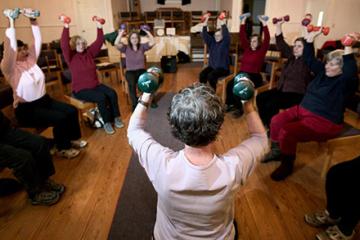Can We Really Slow Age-Related Decline?

Including strength training into a regular program of physical activity and proper diet may help prevent the loss of muscle mass and strength among older adults. (Photo by Stephen Ausmus)
As people age, they begin to lose muscle mass and strength, a condition referred to as sarcopenia. Agricultural Research Service (ARS)-funded scientists are examining the roles of physical activity and diet in slowing or reversing the age-related effects of sarcopenia.
The project is based at the Jean Mayer USDA Human Nutrition Research Center on Aging (HNRCA) at Tufts University in Boston, MA.
“We know that the loss of muscle mass and strength is directly linked to decline in physical functioning and increased rates of disability among older adults,” said Roger Fielding, senior scientist for the Nutrition, Exercise Physiology, and Sarcopenia Team at HNRCA. “That means older people are more likely to lose their independence and have difficulty performing everyday activities of daily living, such as walking, getting up out of a chair, and climbing stairs.”
Researchers are learning more about appropriate nutrition and physical activity recommendations that may help prevent these changes. These include consuming adequate amounts of high-quality dietary protein, ensuring normal vitamin D status, consuming diets high in fruits and vegetables, and including strength training into a regular program of physical activity.
Fielding said that, on average, people lose muscle mass at rates of 0.5 to 1% per year and muscle strength at 1 to 2% per year after about age 35. Among those aged 65 and older, 39% (17.6 million people) have difficulty walking or climbing stairs, including 10 million who are unable to do so at all.
Typically, sarcopenia leads to a reduced level of physical functioning. It is more prevalent with increasing age in women compared to men, and in older adults with other co-morbid conditions, such as heart failure, diabetes, and chronic lung disease.
Fielding’s project has uncovered considerable evidence that regular physical activity can slow the rate of decline in muscle mass and strength. Older adults can increase their muscle mass and strength if they engage in a regular program of resistance/strength training exercise 2 to 3 times per week. Examples of strength training exercises include exercise or elastic bands; weight machines; hand-held weights; calisthenic exercises; digging, lifting, and carrying (gardening); and yoga or tai chi.
In further studies, Fielding and research partners at the Mayo Clinic in Rochester, MN, found that a condition known as cellular senescence may also be associated with mobility problems in older adults.
“Cellular senescence is a process related to the aging of many cells in our bodies,” Fielding explained. “When cells become senescent, they produce and release a number of ‘senescence-associated phenotype proteins’ (SAPP) that negatively affect other cells in the body by causing inflammation and impaired regeneration.”
Fielding said that higher levels of SAPP proteins are associated with decreased strength and functioning, and that people who engaged in higher levels of physical activity had lower levels of these proteins.
“The results of these studies are really exciting because they highlight that fundamental processes related to cellular aging may be modifiable with lifestyle interventions, such as exercise,” Fielding said. “[In addition], this work has formed the basis for a new study that will examine how SAPP proteins and other biological mechanisms of aging are affected by resistance/strength training and may form the basis for how we may individually tailor exercise [programs] based on a person’s underlying biology.” – by Scott Elliott, ARS Office of Communications
Also in our series on Staying Healthy Later in Life:

